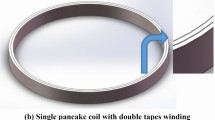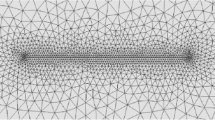Abstract
The second-generation (2G) high-temperature superconducting (HTS) coated conductors (CC) are increasingly used in power systems recently, especially in large-capacity superconducting magnetic energy storage (SMES). HTSCC in superconducting energy storage coil is subjected to thermal stress which is caused by thermal contraction due to AC loss. The thermal stress will degrade the critical currents and may cause the displacement of the superconducting coil and insulating epoxy resin. In this work, the AC loss of the superconducting coil is firstly obtained by finite element method (FEM) software COMSOL with the method of iterative conductivity. Furthermore, the effect of AC loss on the superconducting coil is thus analyzed by solving the coupling problems which include magnetic field, mechanical behaviors, and heat transfer in solids. The result shows that the AC loss of the superconducting coil is concentrated in the middle of the coil and the maximum AC loss density is 5.96 × 105 W/m3; the maximum stress laid at the inner radius of the coil and the maximum stress is 0.01 MPa.
Similar content being viewed by others
Avoid common mistakes on your manuscript.
1 Introduction
With the discovery and application of YBCO, the second generation (2G) high temperature superconducting (HTS) material, superconducting technology and modern power technology have been combined to produce advanced power equipment such as cables, transformers, current limiters, and energy storage. HTS energy storage system has the function of storing electromagnetic energy. Compared with other conventional energy storage devices, it has obvious advantages in terms of power density, energy conversion efficiency, and response speed. YBCO HTS tape under the alternating magnetic field, the movement of the magnetic flux line causes the tape to produce AC loss, and the temperature rise caused by the AC loss is the main reason of thermal stress and strain for superconducting tape. The YBCO tapes used in superconducting coil are brittle materials so that their performance is considerably affected by strain. Therefore, it is necessary to analyze the AC loss of the superconducting coil.
Many analytical and numerical methods for two dimensional (2D) and axisymmetric problems have been proposed for the calculation of superconductor AC loss [1], but the analysis solutions can only be applied to simple geometries. For more complex problems, methods such as FEM and finite difference time domain method (FDTD) have been proposed [2, 3]. In the simulation of superconducting coil, the solving equations applied by the finite element method are: magnetic vector-electric scalar equation (A − V equation), electric vector-magnetic scalar equation (T −Ω equation), and the H- formulation. These three equations are similar, but due to the difference of parameters and partial differential equation, the computational complexity also different [4]. The dependence of resistivity on the amount of current makes it difficult to calculate the AC loss of the superconductors [5,6,7]. The reason is that a circular dependency arises because the current-density calculation contains the resistivity which means the resistivity dependent on itself and the highly nonlinear electric field-current density (E − J) characteristics increase the difficulty of calculation [8, 9]. In this work, an efficient calculation method based on theA − V equation is proposed. To avoid the circular dependency of the resistivity and current density, The E − J power-law relation is described by the relationship between the resistivity and the electric field strength, and then the AC loss of the 3D model of superconducting coil is analyzed.
The superconducting tapes will produce thermal stress and strain due to thermal expansion in operating process [10]. The stress can degrade the performance of the superconducting coil, and may cause the separation of superconducting tape and insulating epoxy resin [11,12,13,14]. Research on Lorenz force - strain relationship appears in large quantity, but most of the work done so far has not considered the strains caused by thermal contraction due to AC loss. In this study the superconducting coil strain caused by AC loss was calculated by coupling model of magnetic fields and solid mechanics and heat transfer.
2 Finite-Element Modeling of Superconducting Coil
2.1 Model of HTS Conductivity
In the COMSOL software, the magnetic field interface of the AC/DC module uses the A − V equation. The magnetic flux density B and the electric field intensity E are described by using the magnetic vector potential A and the electric scalar potential V, as follows:
The starting point for the calculation of the distributions of magnetic fields and current densities in and around a conductor (not only a superconductor) is Ampere’s law (3).
The high-temperature superconducting tape E − J characteristic curve equivalent resistivity model can be expressed as
The relationship between the critical current density and magnetic field is expressed as (5); EC is the critical electric field, JC0 is the critical current density in the self-field, B|| represents the magnetic field strength parallel to the tape direction, B⊥ represents the magnetic field strength in the vertical tape direction, and k, β, and B0are characteristic parameters of the tape, usually 0 < k < 1.
In order to avoid circular iterations of the conductivity and current density, the relationship between conductivity and electric field strength was used to calculate conductivity. The equation can be expressed as (6): m and P are constants which are material-specific. The parameters used in the simulations were m = 0.3, P = 0.04, EC = 1 × 10−4 V/m, JC0 = 1 × 108 A/m², k = 0.2, and β = 0.7, which are typical values for YBCO tape [15]. The parameters in this study are found at the condition of minimal discrepancy between the experimental date and numerical results. For numerical reasons, E must not be zero. This can be done by adding a small value. In the simulations shown in this study, a value of 1 × 10−8 was used.
By iteratively modeling the conductivity of the model material, this method can be used to characterize highly nonlinear E − J characteristics of superconductors.
2.2 AC Loss Analysis of the Model Coil
Hysteresis loss is the main component of AC loss of the second-generation high-temperature superconductor YBCO. In the alternating magnetic field, the conductor generates induced current, which in turn causes the movement of magnetic flux line. Because magnetic flux lines are hindered by flux pinning, the hysteresis loss is generated in the superconductor. The hysteresis loss can be calculated using an electric method. An electric field is induced by the (time-varying) applied magnetic field. An induced current starts to flow, so there is a local non-zero product of voltage and current. The product E ⋅ J integrated over the conductor cross-sectional area and magnetic field cycle yields the loss. In this study, the parameters of the coil are listed in Table 1. The coil was exerted with 1800 + 1800sin (100πt) (A) of alternating current to analyze the distribution of the AC loss in the superconducting coil.
2.3 Stress Analysis of the Model Coil
The stress and strain distribution inside a HTS insert is one of the key issues for construction of a HTS magnet. Many studies have considered the Lorenz force when the coil circulates the current, but the thermal expansion caused by the AC loss also degrades the performance of the superconducting coil and destroys the mechanical structure of the coil. In the simulation, the average finite element model was adopted. In order to study the stress and strain characteristic of the superconducting coil, a multiphysics model should be founded. In the solution of the distribution of the heat, a magnetic field and solid heat transfer coupling model was used; in the mechanical analysis, a thermal expansion structural model was founded.
The magnetic problem is governed by (3) and (6). In the solid heat transfer module, the heat transfer is expressed by the following equation with adiabatic boundary conditions:
The equation includes the following material properties: density ρ, heat capacity cp, and thermal conductivity k. Also, ∇2 denotes the Laplace operator, T and Q are temperature and a heat source, Q in our problem is referred to as electromagnetic volumetric loss density formulated as
J is the electrical current density obtained from the magnetic field solution, and σ is the electrical conductivity presented in (6). The thermal parameters used in the simulations are k= 6 W/(m⋅K), ρ = 5400 kg/m³, and cp = 200 J/(kg⋅K) [16], and the initial temperature in the simulation is 77 K.
The thermal expansion mechanical model is represented as a linear elastic model. This model contains only thermal loads and is expressed by the following equation:
where λ and μ are the Lamé parameters, u is the displacement vector, and the thermal force FT(T) is given by
where D is the elasticity matrix, α is the thermal expansion coefficient, and Tref is the reference temperature. In our problem, superconducting material is represented as orthotropic material, and the elasticity matrix is represented by Young’s modulus, Poisson’s ratio, and the shear modulus shown in Table 2 [17, 18]. The parameters used in the simulations are α = 1.59 × 10−5 1/K and Tref = 77 K. Temperature distribution in the coil is obtained from the heat transfer solution and acts as a load for the mechanical problem. The boundary condition is the fixed constraint at the whole outer radius and inner radius of the coil.
Models: magnetic field, solid heat transfer, and thermal expansion structural are discretized by means of a low-order finite element discretization on a quadrilateral and/or triangular grid.
3 Results and Discussion
3.1 AC Loss Calculation of the Model Coil
In this work, the AC loss of the superconducting coil was analyzed by FEM simulation software COMSOL. In the solution of the AC loss of the superconducting coil, an efficient method of iterative conductivity to characterize highly nonlinear E − J characteristics of superconductors was used.
The section of the superconducting coil is exerted with 1800 + 1800sin (100πt) (A) of alternating current, and the magnetic field distribution of the superconducting coil is shown in Fig. 1. As presented in Fig. 1, the maximum magnetic flux density lies at the inner radius of the superconducting coil, and the maximum magnetic flux density is 0.02 T.
Figure 2 shows the AC loss distribution of the superconducting coil. The AC loss at the middle of the superconducting coil is greater than the AC loss at both sides of the superconducting coil. The maximum AC loss density is 5.96 × 105 W/m3. The result is consistent with the superconducting multi-turn coil inductance distribution. As shown in Fig. 3, the inductance of each turn in the middle of the coil is larger than the inductance of each turn in both sides of the coil, and g is the distance between the turns of the coil increased from 180 to 380 μ m.
The value of the AC loss of the superconducting coil can be obtained by the volume fraction of the coil. At 0.09 s, the AC loss of the superconducting coil is 219.99 W. If the heat generated by the AC loss cannot be dissipation in time, the thermal stability of the superconducting magnet will be destroyed. In this study, we analyzed the AC loss distribution of the superconducting coil, and from the results, we can optimally design the thermal transfer structure of the superconducting magnet to improve the thermal stability of the superconducting magnet.
3.2 Stress Calculation of the Model Coil
The thermal stress and strain caused by AC loss was analyzed by FEM software COMSOL. In the solution of the AC loss heat source and thermal stress and strain, a coupled interface of heat transfer and solid structure was used. Moreover, the thermal expansion was the load of the structural model.
Figure 4 shows the Von Mises stress of the superconducting coil. The maximum Von Mises stress lies at the inner radius of the coil and the maximum stress is 0.01 MPa. The minimum Von Mises stress appears at the outer radius of the coil and the minimum stress is 0.001 MPa. Figure 5 shows the first principal strain of the superconducting coil. The large strain lies in the place where the large stress is and the maximum strain is 2.21 × 10−7. The result shows the effect of the AC loss on thermal stress and the strain of superconducting coils.
Figure 6 shows the total displacement of the superconducting coil. The maximum displacement caused by the thermal expansion is 8 × 10−7 mm. Non-uniformity in displacement distribution may result in the separation of superconducting coils and insulating epoxy layers.
4 Conclusions
In this work, an efficient method is proposed to calculate the AC loss of the superconducting coil. A coupled model of magnetic fields and mechanical behaviors and solids heat transfer is used to analyze the influence of AC loss on thermal stress and strain of the superconducting coil. The result shows the AC loss at the middle of the superconducting coil is greater than the AC loss at both sides of the superconducting coil, and the maximum AC loss density is 5.96 × 105 W/m3; the maximum stress lies at the inner radius of the coil and the maximum stress is 0.01 MPa. The maximum displacement of the superconducting coil caused by the AC loss is 8 × 10−7 mm. This work can help to analyze the stability of superconducting magnets.
References
Pardo, E.: AC loss calculation in coated conductor coils with a large number of turns. Supercond. Sci. Technol. 26(26), 105017–105024(8) (2013)
Reiss, H.: Finite element simulation of temperature and current distribution in a superconductor, and a cell model for flux flow resistivity–interim results. J. Supercond. Novel Magn. 29(6), 1405–1422 (2016)
Henning, A., Lindmayer, M., Kurrat, M.: Simulation setup for modeling the thermal, electric, and magnetic behavior of high temperature superconductors. Physics Procedia. 36, 1195–1205 (2012)
Gömöry, F., Vojenčiak, M., Pardo, E., Šouc, J.: Magnetic flux penetration and AC loss in a composite superconducting wire with ferromagnetic parts. Supercond. Sci. Technol. 22(3), 56–56 (2009)
Dobzhanskyi, O., Gouws, R.: Performance analysis of a permanent magnet transverse flux generator with double coil. IEEE Trans. Magn. 52(1), 1–11 (2015)
Gömöry, F., Vojenc̆iak, M., Pardo, E., Solovyov, M., S̆ouc, J.: AC losses in coated conductors. Supercond. Sci. Technol. 23(3), 034012 (2010)
Wang, L., Wang, Q.: Analysis of current and magnetic distributions in REBCO superconducting coated conductors in self- and external fields. J. Supercond. Novel Magn. 27(5), 1159–1166 (2014)
Ueda, H., Kim, S.B., Noguchi, S., Ishiyama, A., Miyazaki, H., Iwai, S., Tosaka, T., Nomura, S., Kurusu, T., Urayama, S., Fukuyama, H.: Electromagnetic analysis on magnetic field and current distribution in high temperature superconducting thin tape in coil winding. Electromagnetic Field Computation IEEE 1-1 (2017)
Kario, A., Vojenčiak, M., Grilli, F., Kling, A., Jung, A., Brand, J., Kudymow, A., Willms, J., Walschburger, U., Zermeno, V., Goldacker, W.: AC characterization of pancake coils made from Roebel-assembled coated conductor cable. IEEE Trans. Appl Supercond. 25(1), 1–4 (2014)
Zhu, G., Cheng, J.S., Li, L.K., Liu, J.H., Zhou, J.B., Dai, Y.M.: Effect of epoxy insulation on strain distribution in superconducting coil. IEEE International Conference on Applied Superconductivity and Electromagnetic Devices. IEEE 425-426 (2016)
Evans, D., Knaster, J., Rajainmaki, H.: Vacuum pressure impregnation process in superconducting coils: best practice. IEEE Trans. Appl. Supercond. 22(3), 4202805–4202805 (2012)
Ohira, S., Nishijima, S.: Wire dynamics simulation of impregnated superconducting magnet. IEEE Trans. Appl. Supercond. 11(1), 1474–1477 (2001)
Xu, Q., Iio, M., Nakamoto, T., Yamamoto, A: Analysis of strain distribution in A15-type superconducting coils under compressive stress. IEEE Trans. Appl. Supercond. 24(3), 1–5 (2013)
Ren, Y., Wang, F., Chen, Z., Chen, W.: Mechanical stability of superconducting magnet with epoxy-impregnated. J. Supercond. Novel Magn. 23(8), 1589–1593 (2010)
Celebi, S., Sirois, F., Lacroix, C.: Collapse of the magnetization by the application of crossed magnetic fields: observations in a commercial Bi:2223/Ag tape and comparison with numerical computations. Supercond. Sci. Technol. 28, 025012 (2015)
Naseh, M., Heydari, H.: Thermo-electromagnetic analysis of radial HTS magnetic bearings using a semi-analytical method. IET Electr. Power Appl. 11(9), 1538–1547 (2017)
Kim, K.M., Kim, A.R., Park, H.Y., Kim, J.G., Park, M., Yu, I.K., Kim, S.H., Sim, K., Seong, K.C., Won, Y.J.: Design and mechanical stress analysis of a toroidal-type SMES magnet. IEEE Trans. Appl. Supercond. 20(3), 1900–1903 (2010)
Liu, H., Song, G., Feng, W., Qiu, M., Zhu, J., Rao, S.: Strain characteristic of a toroidal HTS-SMES fabricated by YBCO stacked-tape cables. IEEE Trans. Appl. Supercond. 27(4), 1–5 (2017)
Funding
This work is supported by the National Science and Technology Major Project of the Ministry of Science and Technology of China (Grant No. 2016YFE0201200)
Author information
Authors and Affiliations
Corresponding author
Rights and permissions
About this article
Cite this article
Chen, Z., Geng, G. & Fang, J. Influence of AC Loss on Stress and Strain of Superconducting Coils. J Supercond Nov Magn 32, 549–555 (2019). https://doi.org/10.1007/s10948-018-4767-8
Received:
Accepted:
Published:
Issue Date:
DOI: https://doi.org/10.1007/s10948-018-4767-8










